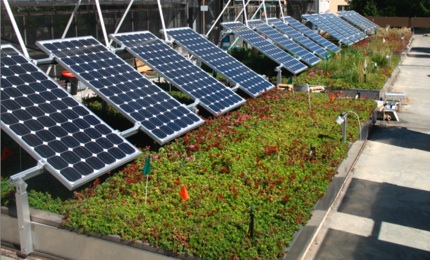Portland State U Researchers Try To Increase Solar Panel Production with Green Roofs
When people think of Portland, OR, a city that receives approximately 40 inches of rainfall a year, they're not likely to think of solar energy research. But that's exactly what's happening under the direction of Portland State University Chemistry Professor Carl Wamser, who is quick to point out that Oregon receives more annual sunlight than Germany or Japan, the two countries leading the world in solar energy production.
Wamser's group, co-led by PSU's Professor of Mechanical and Materials Engineering and Director of the Green Building Research Laboratory David Sailor and Assistant Professor in the Biology Department and Center for Life in Extreme Environments Todd Rosentiel, is looking into the effects of combining single-cell silicon photovoltaic (PV) solar panels with green roof technology.
Wamser said that the idea came from other research he was doing to develop thin-film organic PV panels.
"We talked to some people who heard about our facility and said it would be really cool to combine it with a green roof underneath some of these and actually see how well they work together," Wamser said. So he recruited Sailor and Rosentiel to look into the energy production and biological issues associated with the research.
| | 
Wamser's project includes four green roof pans. Two pans are planted with sedum only, and two others are planted with a mix of sedum and other plants. One of each was irrigated over the summer while the other two were allowed to dry out naturally. | |
The project they came up with, located on the roof of PSU's Science Building 2, consists of four pans totaling 720 square feet of planting area for the green roofs with PV panels donated by SolarWorld partially shading the back half of the pans. The project is funded in part by a grant from the National Science Foundation of more than $600,000 for three years, and was installed in 2010.
The city of Portland, "with moderate but near continuous winter rainfall" according to the city's Bureau of Environmental Services (BES), has a history of problems with its sewage system overflowing and flooding the nearby Willamette River during winter storms, prompting city representatives to advise the public to avoid the river for days at a time.
One of the advantages of green roofs is that they absorb water that would flow off a traditional roof and into the sewers. In a 2002 report looking into the water retention capabilities of two green roofs in Portland, BES calculated that 69 percent of all rainfall was absorbed.
Other advantages of green roofs include:
- Increased building insulation leading to reduced energy costs;
- Reduced urban heat island effect;
- Absorption of pollutants from rainwater; and
- Extended roof life.
More relevant to the PSU project, green roofs lower the temperature of the air around them. Wamser believed that since the silicone in a PV panel is a semiconductor, and semiconductors are more efficient when they're cooler, locating arrays over the green roofs might increase their output.
On the other side of the equation, the PV panels provide shade for the plants in the pans. While the rain may seem as if it never stops during the Portland winters, it can be hard to come by in the summer when average monthly rainfall is approximately three inches and 30-60 day stretches without any rain at all are common.
Because of the lack of moisture during the summer, green roofs in Portland are usually planted with sedum, a succulent plant native to the area that holds moisture and weathers the summers better than many other plants. They still suffer heat damage, though. By shading the plants, the PV panels protect them and allow them to stay healthier and more efficient year-round.
But Wamser said he thinks the efficiency of the roofs and panels can be increased even more through irrigation and greater biodiversity in the pans.
"In a perfect green roof, you would put it up there and never have to think about it again," Wamser said. "We're examining the concept that if you give it a little bit of water, especially during the summer, when it needs it, it might be able to fulfill all those [storm water runoff] functions so much better that it was worth it to put a little irrigation in there."
To explore both of these questions, they've planted two of the pans with a sedum mix, and two of the pans with a mixture of sedum and herbaceous plants such as sage, thyme, grasses, and yarrow. Over the summer, the team has been irrigating one sedum pan and one mixed pan, while letting the other two dry out naturally.
"The goal of this is to understand summer maintenance requirements as a function of water retention capabilities," said Bailey Johnston, an environmental engineering student at PSU who was hired by Rosentiel with the goal of better understanding the water management requirements of the roof plots. "Does summer irrigation have an effect on water retention? As the winter rains are returning we will begin to see the results of the summer irrigation."
To track their results, the team is measuring the moisture in the soil, the temperature in the pans and on the panels, the amount of water that goes into the pans and the amount that comes out. They also have a weather station and a webcam on the roof. All the data will later be integrated on the group's website, which "is changing almost daily," according to Wamser.
"We'd like to think that all that data will be useful for researchers and educators," said Wamser, adding that the site includes a dashboard that could be useful for classroom instruction.
The NSF grant will expire in March 2012, though Wamser says that he intends to request a renewal. Other sponsors of the research include:
More information is available at solar.pdx.edu.